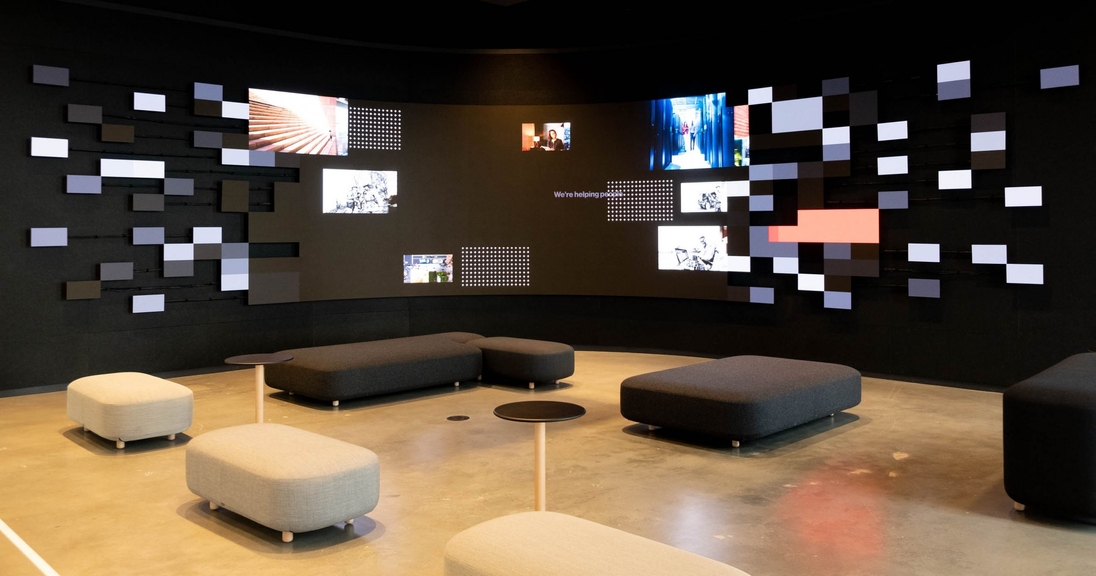Since LED displays came onto the scene in the 1970’s, they have always held viewers in awe. Bright, bold colors, mixed with stunning, moving images have paved the way for many innovations. In the past, displays were a lot larger with thick bezels and heavy screens. Over time, dvLED displays have continued their metamorphosis and are becoming thinner, brighter, and flexible enough to suit any application.
These days, many AV designers are seeing dvLED in a different light and are beginning to create new concepts to integrate this vibrant technology into their projects. LED has become so versatile, thin, and ubiquitous that it can easily be integrated into any project. With the increase in popularity in recent years, we have seen some emerging trends in direct-view LED displays that are worth taking note.
Here are some interesting trends we are seeing in the industry…
Smart dvLED Technology
Smart technology is an amazing advancement in dvLED. Self-correcting tiles that autocalibrate, and color match neighboring tiles are incredible. With this innovation in dvLED technology, gone are the days of frequent tile replacement and hours of color calibrating by hand.
Eco-Friendly dvLED Lighting
Sustainability is something we will increasingly hear more about in the future. Many businesses are turning to dvLED solutions due to their energy efficiency and lower environmental impact. dvLED displays are more energy-efficient and require fewer materials to manufacture, making them an optimal choice for businesses looking to reduce their carbon footprint. If you have not read about AVIXA’s Sustainability Initiatives, we suggest you do, as green initiatives will continue to trend.
Fine Pixel Pitches
Pixel pitch refers to the distance between each LED on a display. The smaller the pixel pitch, the higher the resolution of the display. Fine pixel pitch displays have become increasingly popular in recent years as they offer incredibly sharp and clear images. This trend is set to continue as manufacturers work to reduce the pixel pitch even further, resulting in even higher resolutions.
Curved Displays & Immersive Displays
Curved displays have been around for a while, but they have recently become more common in direct-view LED displays. Our True Curve™, patented skin-and-frame topology design allows for a more immersive viewing experience, making them perfect for use in large public spaces such as stadiums, concert halls, and shopping centers. The flexibility of these panels, versus faceted panels, means that they can be easily curved to fit any space, making them a popular choice for architects and designers.
By surrounding most of the user’s field of view (FOV), this provides panoramic virtual screens to create experiential and immersive environments. Many industries use these technologies in different ways. For instance, interactive virtual reality (VR) environments offer improved perception to raise engagement and learning in virtual meeting spaces. Immersive screens make it possible for convenient, customized experiences.
Transparency
Transparent displays are an exciting emerging trend in direct-view LED displays. By making the LEDs more transparent, manufacturers can create displays that allow light to pass through them, resulting in an almost see-through effect. This technology opens a whole new range of possibilities, allowing for displays that can be placed in front of windows, or even in front of other objects, without blocking them out completely.
Higher Brightness and Contrast Ratios
Brightness and contrast ratios are critical factors in any display, and direct-view LED displays are no exception. As technology continues to improve, manufacturers are finding new ways to increase the brightness and contrast ratios of their displays. This trend is particularly important for outdoor displays, where high brightness is essential for visibility in direct sunlight.
Integration with Other Technologies
Direct-view LED displays are increasingly being integrated with other technologies to create more immersive experiences. For example, they can be combined with augmented reality (AR) technology to create interactive displays that respond to the user’s movements. They can also be combined with sensors and cameras to create displays that react to the environment, making them ideal for use in smart cities and other public spaces. This also means that content designers are keeping these trends in their sights as they continue to advance the technology of content to work harmoniously with dvLED.
We look forward to seeing what other future emerging trends and advances we will find in the dvLED market.
Have a question regarding LED? No worries we can help > https://www.nanolumens.com/contact

